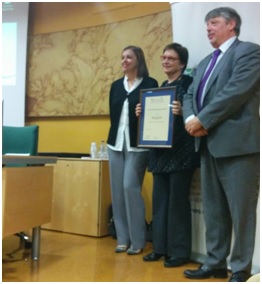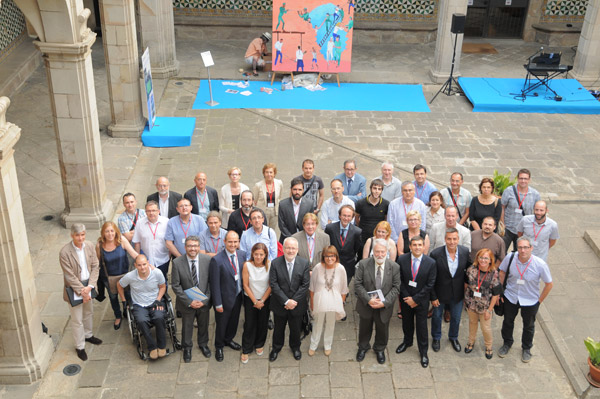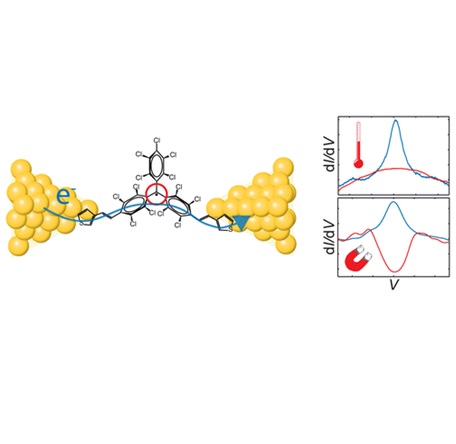
Prof. C. Rovira awarded by Real Sociedad Española de Química (RSEQ)
Concepció Rovira from ICMAB (CSIC / CIBER-BBN) received the Award for Excellence in Research of the Real Sociedad Española de Química (RSEQ) hands of Marina Villegas, CEO of Research in MINECO and the President of the RSEQ Jesus Jimenez-Barbero, .
The RSEQ Awards this year 2015 have gone to:
Medal of the RSEQ:
Prof. José Luis Mascareñas Cid (Singular Center for Research in Biological Chemistry and Molecular Materials (CIQUS) - University of Santiago de Compostela)
Research Excellence Awards:
Prof. Nuria López Alonso, Catalan Institute of Chemical Research (ICIQ).
Prof. Ruben Martin Romo, Catalan Institute of Chemical Research (ICIQ).
Prof. Kilian Muñiz Klein, Catalan Institute of Chemical Research (ICIQ).
Prof. Concepció Rovira Angulo, Institute of Materials Science of Barcelona (ICMAB-CSIC).
Prof. Felix J. Zamora Abanades, Autonomous University of Madrid (UAM).
Divulgation Award:
Ms. Maria Luisa Prolongo Sarria, IES Manuel Romero. Villanueva de la Concepción, Málaga

Nanomedicine to treat diabetic foot
"Nanomedicine" is a new word, but it is heard more and more. It is based on the administration of drugs by very small particles. They act directly on the specific site of the body, hence they are more effective. Using this methodology, Catalan researchers have found a new way to treat ulcers as the so-called "diabetic foot".

Nanomol-ICMAB participated in the NANOFABRY project, one of five featured in Marathon 2009
On June 9th 2015, 16th Symposium on rare diseases was held at the Institute of Catalan Studies, in which the results of 20 research projects funded by TV3 Marathon Foundation in its edition of 2009 were presented.
At the end of the ceremony, Dr. Gabriel Capellà, coordinator of the Scientific Advisory Board of the Foundation, mentioned five outstanding results from all developed projects. Among them, he spoke about the nanoconjugate developed by the NANOFABRY project through the collaboration of the CIBER-BBN groups headed by Dr. Simó Schwartz (VHIR), Prof Jaume Veciana and Dr. Nora Ventosa (Nanomol, CSIC), Dr. Miriam Royo (PCB-UB), and Dr. Pepe Corchero (IBB-UAB) for the treatment of the Fabry’s rare disease. This nanoconjugate is based on unilamellar lipid vesicles, or nanoliposomes, carrying the alpha-galactosidase enzyme as part of an enzyme replacement therapy for the Fabry’s disease. Dr. Capellà highlighted the submission and license of a patent protecting this nanoconjugate, recently licensed to the company Biopraxis Research, together with efforts done by the researchers to bring it to a regulatory pre-clinical stage, and the additional funding achieved by means of two new competitive projects, Lipocell and Terarmet, achieved by the same consortium.

Prof. Jaume Veciana has been named Scientific Director of the Singular Scientific Technological Infrastructures NANBIOSIS
Prof. Jaume Veciana has been named Scientific Director of the Singular Scientific Technological Infrastructures NANBIOSIS. This is one of the 29 ICTS which has been recently recognized by the Spanish Government (MINECO) comprising different units of the Biomedical Research Center in Bioingeneering, Biomaterials and Nanomedicine (CIBER-BBN) and the Centre for Minimal Invasive Surgery Jesus Uson (CCMIJU).
NANBIOSIS provides a wide range of services for the production and characterization of nanomaterials, biomaterials and biomedical devices. This ICTS operates through a single contact point model and is organized into five platforms coordinating 27 service units that belong to CIBER-BBN and CCMIJU and that are distributed throughout the Spanish State (Alava, Badajoz, Barcelona , Caceres, Madrid, Valencia and Zaragoza) which receive support from more than 800 researchers from many different fields and with multidisciplinary experiences.

Kondo effect in a neutral and stable all organic radical single molecule break junction
Riccardo Frisenda, Rocco Gaudenzi, Carlos Franco, Marta Mas-Torrent, Concepció Rovira, Jaume Veciana, Isaac Alcon, Stefan T. Bromley, Enrique Burzurí, Herre S. J. van der Zant
Nano Lett., 2015, 15 (5), pp 3109–3114
It is shown that the paramagnetism of the polychlorotriphenylmethyl (PTM) radical molecule in the form of a Kondo anomaly is preserved in two- and three-terminal solid-state devices, regardless of mechanical and electrostatic changes. Indeed, reported evidences demonstrate that the Kondo anomaly is robust under electrodes displacement and changes of the electrostatic environment pointing to a localized orbital in the radical as the source of magnetism. Strong support to this picture is provided by DFT calculations and measurements of the corresponding non-radical species. These results pave the way towards the use of all-organic neutral radical molecules in spintronics devices and open the door to further investigations into Kondo physics.








 News
News